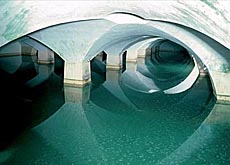Roman treasure hoard offers priceless insights

Pieces of treasure hidden by the Romans 1,650 years ago as Germanic tribes stormed their northern Swiss fort, have been reunited and put on display for the first time.
Some 270 precious items including silver platters, dishes, utensils and coins, are on show amid tight security at the Museum of the Roman town of Augusta Raurica, in Basel.
Weighing 58 kg in total, it is the largest collection of Late Antique silver ever to have been discovered, and conveys a dazzling image of the Roman Empire shortly before the transition to the Middle Ages.
In December 1961, a mechanical digger levelling off a school playing field in Kaiseraugst, canton Aargau, wrenched the treasure out of the ground and dumped it onto a mud heap. It was two months before an archaeologist was taken to the site, where a Roman fortress once protected the inhabitants of nearby Augusta Raurica.
Priceless
The landlady of the local restaurant had discovered five platters in the heap, which she handed over to the specialist. She helped the archaeologist track down a family she had seen poking around at the site, who had taken home an object known as the Achilles dish.
A schoolboy had found an ornate rectangular dish, and presented it to his teacher, who ridiculed his claims that it was Roman and ordered him to throw it away. The priceless platter was recovered from the school bin.
A further 18 silver vessels were bequeathed to the cantonal authorities by an anonymous donor in 1995. They were recognised as part of the 1962 hoard as they included fragments from the original find.
But the vessel which left its imprint on the Achilles dish has never been discovered, so the collection is not complete.
New display techniques
The bulldozer had warped and torn many of the pieces of treasure, which were already tarnished through burial. The dishes were scrubbed, bent back into shape and broken sections were stuck together again.
In 1964, the silverware was displayed as it would originally have looked.
These days, restorers preserve important finds in the form in which they have survived. So the acquisitions of 1995 appear in the Roman museum blackened, sometimes broken, and bearing the marks of the hay in which they were packed.
Exhibition organiser Cathy Aitken told swissinfo: “We can see from the kinks indented in this plate that the packing material was hay rather than grass, so we know the treasure was buried in the second half of the year.”
Servants’ trophies
The objects date back to the tumultuous era between 294 and 350 AD. The name Marcellianus appears on 13 items. It is possible that he and an unnamed owner buried their belongings together and only Marcellianus labelled what was his.
Both men were undoubtedly army officers. An inscription on one of the dishes shows Marcellianus to have been a tribune – a unit commander or staff officer. His candelabrum, made to be packed together like a telescope, hints at a life of frequent travel.
Marcellianus apparently served with the imperial court as the emperor moved about the Balkans and westwards to Gaul.
One of his bowls is from Thessalonica and is a typical gift of the emperor to loyal followers. Another dish celebrates the tenth jubilee of the reign of Emperor Constantine.
The maker’s marks on the Achilles dish and the “Euticus” dish also indicate that they are gifts from the emperor.
Cathy Aitken explained: “The weight of the silver was marked on each piece, indicating that they were given as a form of savings, rather than as tableware for practical use.”
Motifs
Most of the motifs depict hunters, landscapes, and scenes from Greek mythology, reflecting a good education and cultivated lifestyle. In the Late Antique period, geometric motifs appear more frequently, probably due to the increasing presence in high society of barbarians.
Some 1,800 years ago, 20,000 people lived at Augusta Raurica, where you can still find the best-preserved antique theatre north of the Alps, a replica Roman House, and the Roman animal park.
The treasures exhibition in the museum runs until January 31, 2005. It is attracting large crowds at a time when the museum is generally quiet.
swissinfo, Julie Hunt in Augusta Raurica
The silver treasure was discovered in 1962 and comprises 270 items.
In 1995 a further 18 pieces were added, bequeathed by the finder.
The treasure is a priceless reflection of the period prior to 352 AD.
The ensemble is now seen as accumulated capital in the form of imperial and private gifts.
The Kaiseraugst silver treasure is the largest collection of late antique silver ever to have been discovered.
Roman soldiers buried it inside their castle at Kaiseraugst, as they came under attack by the German tribes known as Alamanni.
An excavator levelling a school playing field dug up the silver again 650 years later.
It is believed to have belonged to a high-ranking officer, and includes gifts from two Roman emperors.

In compliance with the JTI standards
More: SWI swissinfo.ch certified by the Journalism Trust Initiative











You can find an overview of ongoing debates with our journalists here . Please join us!
If you want to start a conversation about a topic raised in this article or want to report factual errors, email us at english@swissinfo.ch.